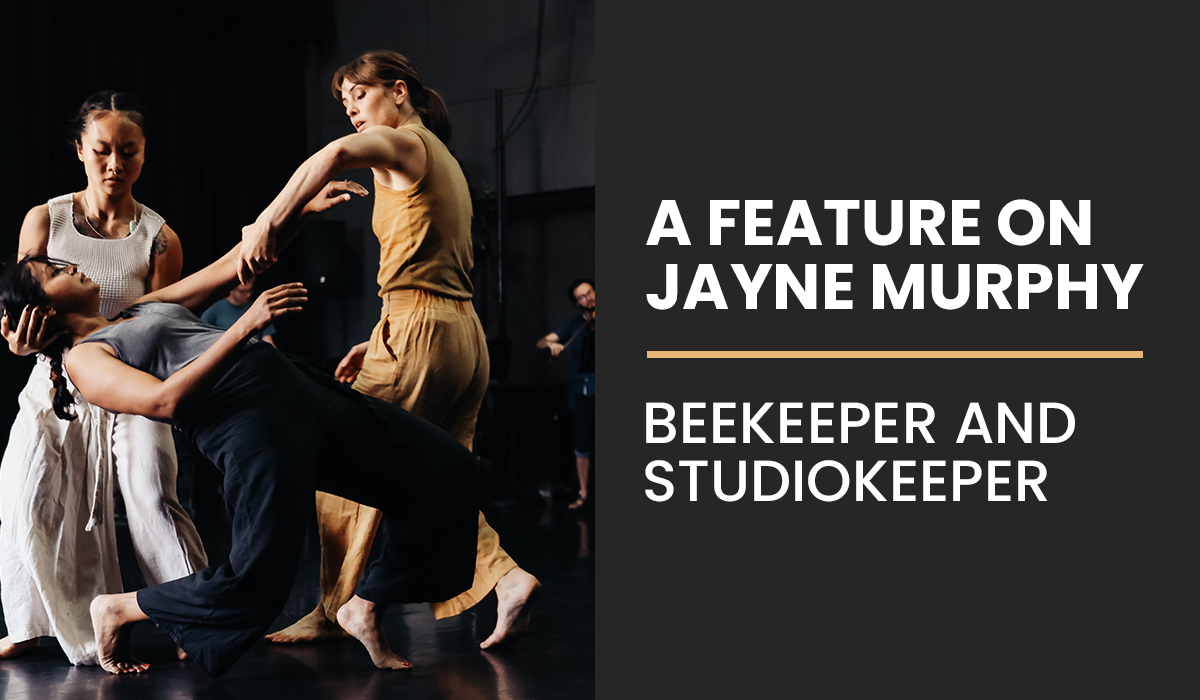
Dancers: IJ Chan, Kristin Wagner, Chavi Bansal
Photos By: Olivia Moon Photography/halfasianlens
Jayne Murphy sees The Dance Complex like no other: in stark detail; in shades of notched wood, steel pins, and brick; in contours of floors. Hers is an x-ray vision so keen it blazes through tides of bodies entering and leaving and lands hard in the soul and bones of the building itself. She was born and raised in Virginia (“a preacher’s daughter”), has worked variously as a house painter, stage manager, sign language interpreter, and South African theater co-founder. She has been the Building Caretaker and Theater Manager at the Complex now for nearly 30 years, after a profound, split-second decision:
It was 1993. Jayne had decided to stop travelling, was new to Boston, and was looking for freelance theater work. A friend of a friend suggested she stage manage a one-off show at a new space. It was called The Dance Complex.
“It was a building built in 1884–a spiritual and community center for the organization called the Oddfellows. Changed hands in the 1960’s or 70’s and became a health club called ‘The Joy of Movement.’ At some point in the early 90s they went bankrupt. The building was locked up, sat empty for a long time – don’t know how long. The dancers in the community somehow got into it, squatted there for a while, and approached the city of Cambridge to turn it over to them. Around ‘92 or ‘93 they were given access to it.” Cue Jayne’s entrance.
“I walked in here, and it was new – it was rough – it was very primitive – it wasn’t taken care of… and I met with the director and said, ‘I’ll do the show, but I also would like to take care of the space. It needs someone.’”
Nearly 30 years later, if the Dance Complex ever needs someone, it has Jayne.
“I protect it. It could be anything from I fix the floors, I fix furniture, maintain the studio and theater equipment – the lights, the cables… I make sure that when anyone walks into any space at all, everything works. It’s a constant protection and preservation mode. It’s always looking at the building, looking at the details, looking down a lot at the floors, the carpets, the stairways…
Making sure everything is safe and fixed. Making sure the heat stays on. The boilers… I try to always fix something before I call the service guys in. Protecting and maintaining and supporting every aspect. From the basement to the attic.”
Jayne grew up learning about architecture, about preservation, about fixing what was broken. Her 1993 split-second decision to designate herself sole caretaker of a hundred-year-old building illustrates more than just her sheer sensitivity to history and legacy; it is a testament to the utter preservability of the building itself.
“What buildings are put up nowadays that stand basically unchanged for 130 years? You have houses that were built in the 70’s that are crumbling, as in starting to fall apart. You don’t see this kind of old wood today anymore, especially at the kind of size that they used for this structure. Basically it’s wood and brick. And steel pins and notched out huge pieces of wood that were so big that you could afford to notch them out and make these things interlock. They kinda just went together, and locked themselves in, and held it together. Wood and brick. And you bring in 200 people or more per day, and their whole intent is the stomp on the floor? I’m just in awe of the integrity of the materials and the craftsmanship, and that’s humbling.”
The building was built to be humbling, surely. Its architects, the Oddfellows, built the structure in 1884 to serve as their local headquarters – a place of fraternity, spiritual ritual, and, most importantly, community service. “Their whole intent was to go out into society and help the underprivileged.” Sure, they also gathered around a kind of exclusive, Anglocentric spirituality that would be utterly out of place as a guiding principle at today’s Complex, but if we’ve learned anything from comparative religious studies, it’s that world religions are, in simplest form, a collection of differing sciences on the same theme of human good, and so most tend toward common goals.
“The three rings on the landing in the marble when you enter and come up the main stairs… you see there are three rings connected. That stands for Love, Friendship and Truth.” The three tenets of the Oddfellows – Amicitia, Amor, et Veritas.
“The symbol there, certainly like any other symbol anywhere, is a reminder to the person seeing it of what the place is all about. The three rings on the landing… and on the outside at the entrance. Two times you see that. It’s a reminder. Friendship, Love, and Truth. They want to just keep telling you – ’this is why we’re here, this is what we’re about.’ Every symbol is up there so people don’t forget.”
And that was the Oddfellows’ vision: To build something that would live after them. Something that would stay standing for 130 years and then some, something that would create a community for the benefit of a society.
“Actually, it’s like we’re doing the opposite of what the Oddfellows did. Same goal, opposite method. They gathered here, gathered their core and their strength, and then went out into the community. The mission of the DC at the beginning was to provide a safe place and affordable space for dancers – who are notoriously poor – to come in and have space to do their work.” The Oddfellows went out. The Dance Complex brings people in.
“I know that a lot of the Oddfellows beliefs and practices are similar to what we should be doing everyday anyway. It’s nice that we have this, not that we refer to them – almost never – but the beliefs are similar to a point.”
The more I talk to Jayne, the more I feel sensitized to the little details I’ve gathered around me for the purpose of remembrance. A cheese board from my mother. Sticky note affirmations, one of which reads, “My love is a potato.” A tiny pawned elf figurine that for all intents and purposes is total garbage but means something to me because of who handed it to me. All of these things mean close to nothing to you. It makes me curious about all the symbols I pass, unaware that they are symbols at all. What’s around me and trying to remind me of what I didn’t know I needed to remember?
“On the newel posts of the stairway, the wood on top, that beautiful wood everybody touches… It’s in the form of a bee skep, which is an old fashioned beehive that beekeepers used long before the white boxes were developed.”
Yes, a symbol. The Oddfellows were no schmucks.
“I didn’t know that those were bee skeps until I started studying about beekeeping. I had wanted to do beekeeping since the late 70’s. I had met an old guy, he taught me how to house paint, and he kept bees. I didn’t know anything about it; I just thought I wanted to do it someday. It took about 35 years to get to that someday. And then I was studying, and I saw a drawing of a bee skep in a book, and I said, Wait a minute – that’s what we have. I put two and two together.
“The Oddfellows used that as their symbol of unity, of working together, and of going out into the community. They could’ve chosen any other topping for a newel post – there are hundreds. Why did they choose the bee skep? Because in a honeybee hive everyone works for the same goal, and everyone is self-less. The Oddfellows worked toward a single purpose, the Dance Complex has a single purpose – with sub-purposes of course… It works for all of us.”
The bee skep is literally everywhere in our building. I can’t walk ten feet without spying another one. The more I see the Dance Complex through Jayne’s eyes, the more I sense how humbling our building can be.
“It’s humbling on a physical level. The sheer size of it. The sheer physical energy you have to use to get in there. If you have to get to studio 6 four or five times a day… That’s humbling.”
Like a bee in a hive tens of hundreds of times bigger than it. A bee, crowded amongst all of its siblings, working variously toward one goal.
A group of dancers, masked, shaking away two years’ worth of trauma–not to mention the rest of it.
“Memories are short. Spans of attention are growing shorter by the day. We need reminders to keep bringing us back to where we wanna be. Our center.”
If you need me, I’ll be at The Dance Complex, studying the details.
Jordan Palmer
Communications Associate
The Dance Complex

